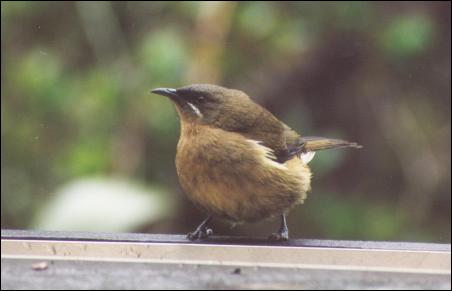Public helps build profile of bellbird
Public helps build profile of bellbird
Keen North Canterbury bird-watchers are helping researchers discover more about the distribution of one of our finest songbirds * the bellbird. The information paints a positive picture of the birds' presence in our region.

Bellbirds (Anthornis melanura), or korimako, are found only in New Zealand and have a bell or flute-like call. They are common in most parts of the country, except Auckland and Northland. Many people are keen to attract bellbirds to their urban gardens.
Landcare Research scientists have asked Cantabrians from Ashburton to the Conway River to enter bellbird observations into a Landcare Research website. The observations are helping scientists learn more about the bird's survival, dispersal and breeding, and how best to sustainably manage the birds. Dr Heather North says over the past six months, 160 people have completed the internet-based questionnaire. Dr North says their responses show that the bellbird's distribution is wider than researchers had expected.
"Bellbirds travel fairly widely to feed during the winter, but there have also been a surprising number of bellbird observations outside the main bush areas during the breeding season.
"This is good news for those who would love to hear the bellbird in their own garden. In fact, most of the observations were made in peoples' gardens and farms."
Dr North says the information reinforces the fact that bellbirds feed on a wide range of flowering and fruiting plants, as well as insects. They prefer tall trees where they can feed and sing.
"The bellbirds' distribution patterns in Christchurch City reflect this. Though they breed primarily in the native bush patches of the Port Hills, they also forage in the hill suburbs and Spreydon. Flowering gum trees draw the birds to areas like Hagley Park during the winter. However these exotic trees would not be as important if we had more nectar- and fruit-producing native trees like kowhai and five finger in the city."
Dr North says
researchers will carry on collecting data for another six
months. "Once we have a full year of data, we plan to look
more closely at the seasonal distribution of bellbirds in
North Canterbury, to get a more complete picture of bellbird
habitat usage in the region." Native bird observation
website (sightings of bellbirds and other birds):
http://www.landcareresearch.co.nz/research/biodiversity/bellbird
A map showing bellbird distribution is available on request.


 Gordon Campbell: On The Public Sector Carnage, And Misogyny As Terrorism
Gordon Campbell: On The Public Sector Carnage, And Misogyny As Terrorism National Maori Authority: Maori Authority Warns Government On Fast Track Legislation
National Maori Authority: Maori Authority Warns Government On Fast Track Legislation NZ Government: Comprehensive Partnership The Goal For NZ And The Philippines
NZ Government: Comprehensive Partnership The Goal For NZ And The Philippines DoC: Canterbury Spotted Skink In Serious Trouble
DoC: Canterbury Spotted Skink In Serious Trouble Te Pāti Māori: Oranga Tamariki Cuts Commit Tamariki To State Abuse
Te Pāti Māori: Oranga Tamariki Cuts Commit Tamariki To State Abuse NZCTU: Inflation Data Shows Need For A Plan On Climate And Population
NZCTU: Inflation Data Shows Need For A Plan On Climate And Population Statistics New Zealand: Annual Inflation At 4.0 Percent
Statistics New Zealand: Annual Inflation At 4.0 Percent


